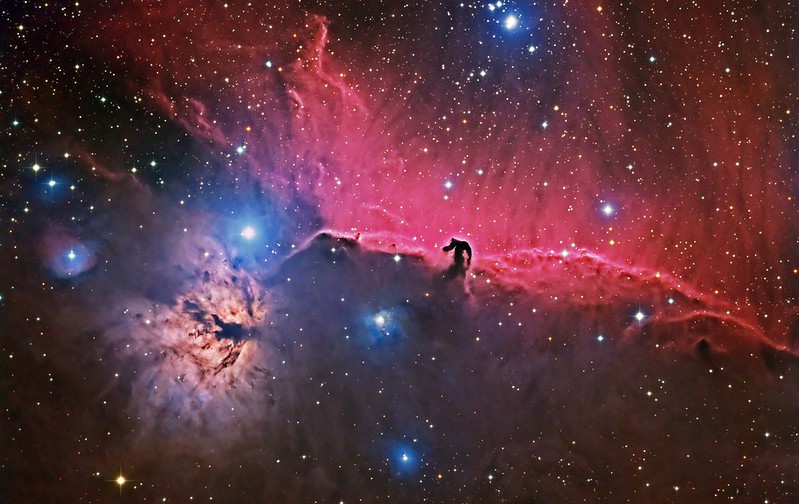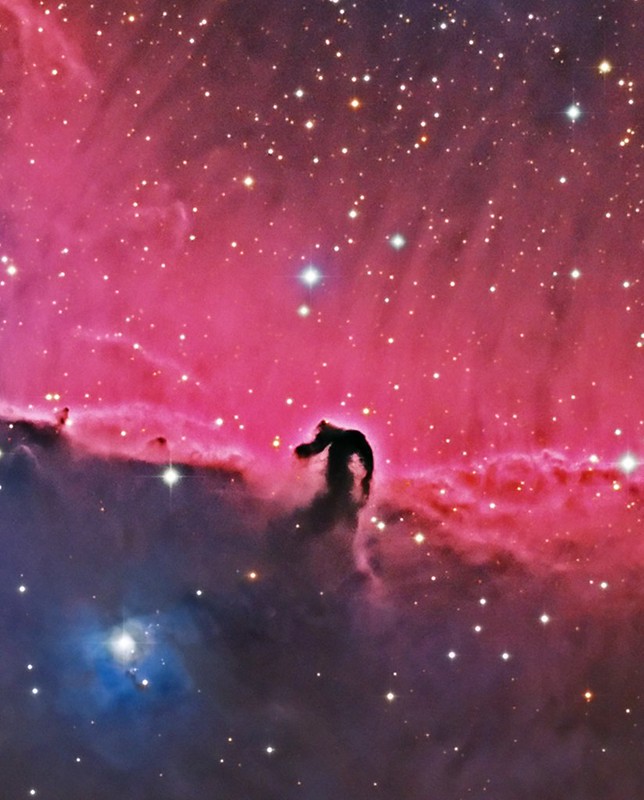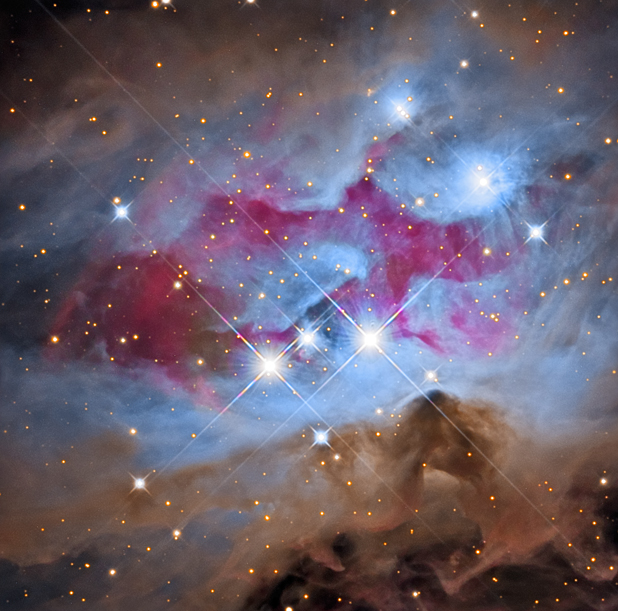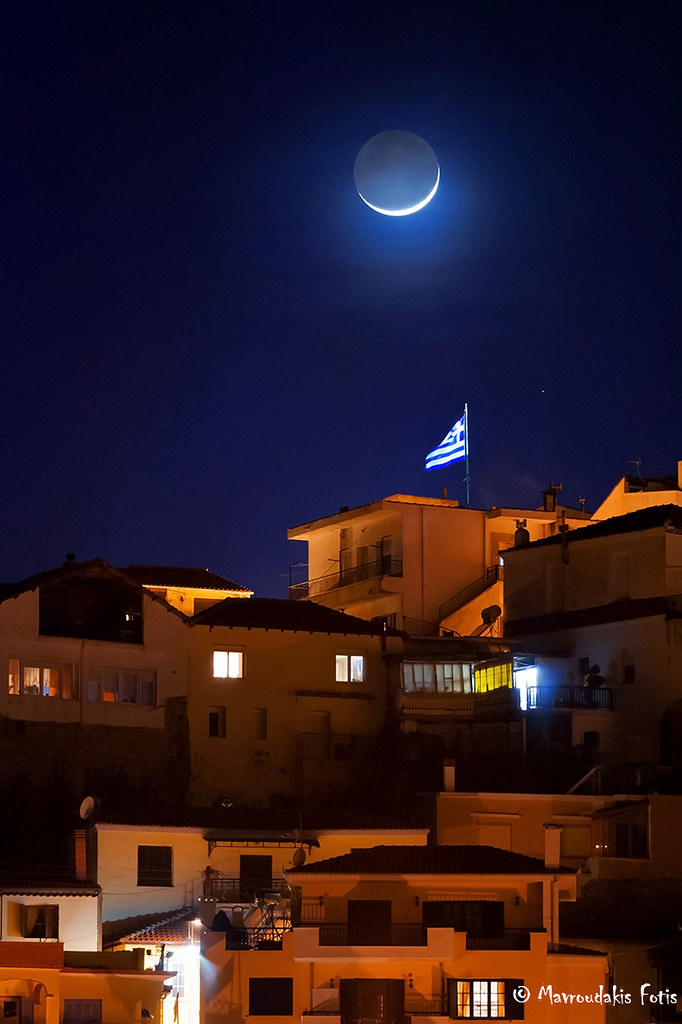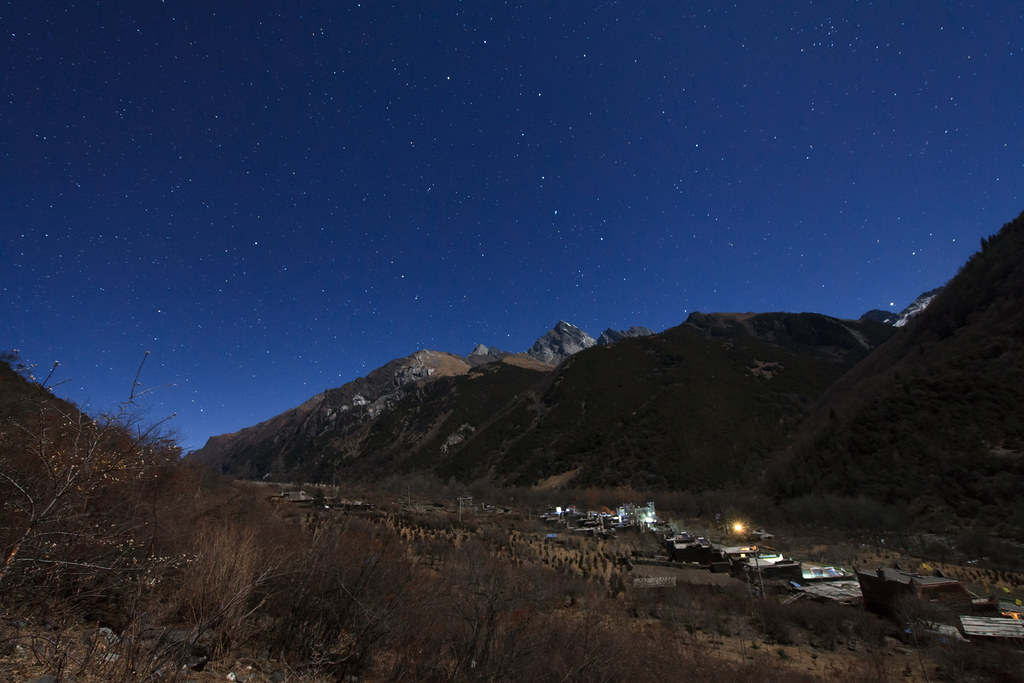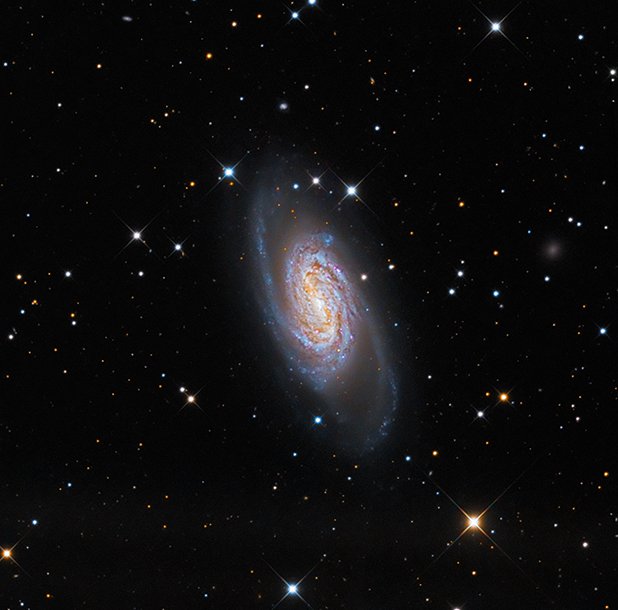Submissions: 2013 January
Re: Submissions: 2013 January
Messier 78 in Orion
http://www.rolfolsenastrophotography.com
Copyright: Rolf Wahl Olsen Link to large (2.5MB) image
Messier 78 is a spectacular reflection nebula in the constellation Orion. It is located just to the north east of Orion's Belt at a distance of about 1500 light years. The area comprises the nebulae NGC 2064, NGC 2067, NGC 2068 and NGC 2071.
In the centre of Messier 78 lies two bright stars, HD 38563A and HD 38563B, which cause the illumination of the area's dense clouds of gas and dust. The nebula is mostly blue due to the reflection and scattering of light from the young bright stars, but this light is reddened significantly in places where complex patches of thick dust clouds obscure the scene.
Throughout the image several Herbig-Haro objects can also be seen, especially towards the upper left. These are small reddish irregular patches of nebulosity caused by jets shooting out from newborn young stars within the clouds.
Also visible in this image is McNeil's Nebula, discovered by amateur astronomer Jay McNeil in 2004. This nebula appears to be illuminated by a variable light source, most likely a young stellar object that is undergoing outbursts from time to time. Previous images of Messier 78 do not show the nebula, except one taken in 1966. The frequency of this objects variability is currently unknown.
Messier 78 is part of the large Orion Molecular Cloud Complex which also includes the famous Orion Nebula itself (Messier 42/43), Horsehead Nebula, Flame Nebula, Barnard's Loop and several other objects as well as the Orion OB1 Association of hot giant stars.
Despite its overall visual splendour and striking appearance the nebula appears somewhat overlooked though, probably due to Orion's many other prominent objects of interest drawing the attention of astrophotographers.
Image details:
Date: 9th, 10th, 13th, 14th, 19th December 2012 and 1st, 4th, 5th January 2013
Exposure: LRGB: 525:82:84:75m, total 12hrs 46mins @ -29C
Telescope: 10" Serrurier Truss Newtonian f/5
Camera: QSI 683wsg with Lodestar guider
Filters: Astrodon LRGB E-Series Gen 2
Taken from my observatory in Auckland, New Zealand
http://www.rolfolsenastrophotography.com
Copyright: Rolf Wahl Olsen Link to large (2.5MB) image
Messier 78 is a spectacular reflection nebula in the constellation Orion. It is located just to the north east of Orion's Belt at a distance of about 1500 light years. The area comprises the nebulae NGC 2064, NGC 2067, NGC 2068 and NGC 2071.
In the centre of Messier 78 lies two bright stars, HD 38563A and HD 38563B, which cause the illumination of the area's dense clouds of gas and dust. The nebula is mostly blue due to the reflection and scattering of light from the young bright stars, but this light is reddened significantly in places where complex patches of thick dust clouds obscure the scene.
Throughout the image several Herbig-Haro objects can also be seen, especially towards the upper left. These are small reddish irregular patches of nebulosity caused by jets shooting out from newborn young stars within the clouds.
Also visible in this image is McNeil's Nebula, discovered by amateur astronomer Jay McNeil in 2004. This nebula appears to be illuminated by a variable light source, most likely a young stellar object that is undergoing outbursts from time to time. Previous images of Messier 78 do not show the nebula, except one taken in 1966. The frequency of this objects variability is currently unknown.
Messier 78 is part of the large Orion Molecular Cloud Complex which also includes the famous Orion Nebula itself (Messier 42/43), Horsehead Nebula, Flame Nebula, Barnard's Loop and several other objects as well as the Orion OB1 Association of hot giant stars.
Despite its overall visual splendour and striking appearance the nebula appears somewhat overlooked though, probably due to Orion's many other prominent objects of interest drawing the attention of astrophotographers.
Image details:
Date: 9th, 10th, 13th, 14th, 19th December 2012 and 1st, 4th, 5th January 2013
Exposure: LRGB: 525:82:84:75m, total 12hrs 46mins @ -29C
Telescope: 10" Serrurier Truss Newtonian f/5
Camera: QSI 683wsg with Lodestar guider
Filters: Astrodon LRGB E-Series Gen 2
Taken from my observatory in Auckland, New Zealand
Re: Submissions: 2013 January
hi, this is my first submission to APOD.
The image was taken January 6, 2013 in front of the 6.5m Magellan Telescopes at Las Campanas Observatory in Chile. I observe there several times a year and I took a student along this time. She plays the flute and decided to play a little music by the telescopes during sunset. It was beautiful!
thanks,
Anna
The image was taken January 6, 2013 in front of the 6.5m Magellan Telescopes at Las Campanas Observatory in Chile. I observe there several times a year and I took a student along this time. She plays the flute and decided to play a little music by the telescopes during sunset. It was beautiful!
thanks,
Anna
-
russelleking
- Ensign
- Posts: 54
- Joined: Sun Jun 05, 2011 2:03 am
Re: Submissions: 2013 January
russelleking wrote:A 2% Waning Moon and Venus
The Moon, which was 2% of full and the Planet Venus were in close approach on the morning of January 10, 2013. I shot this pictures with my Canon EOS Rebel Xsi Digital Camera from my home in Neptune, New Jersey. I used my Canon 75-300mm lens set at 300mm. Camera was set on manual. Fstop was f/5.6. Exposure was for 1 sec. ISO was 800. Visually pleasing for the length of time it was visible to the naked eye.
http://www.rddnj.com
Copyright: Russell E. King
-
Wade Earle
Re: Submissions: 2013 January
-
Paul Haese
- Ensign
- Posts: 80
- Joined: Tue Feb 01, 2011 10:38 pm
-
Nick P
Re: Submissions: 2013 January
The Great Wall area in Cygnus.
Thanks for looking up.
Nick Pavelchak

Link http://www.astrobin.com/21175/
Thanks for looking up.
Nick Pavelchak

Link http://www.astrobin.com/21175/
Last edited by bystander on Sun Jan 13, 2013 2:28 am, edited 2 times in total.
Reason: please, no hot links to images > 400kb, smaller image substituted
Reason: please, no hot links to images > 400kb, smaller image substituted
- marion165
- Science Officer
- Posts: 117
- Joined: Fri Oct 21, 2011 6:27 pm
- Location: Lancaster, PA USA
- Contact:
Re: Submissions: 2013 January
28 Hour Moon Setting over the Forest
http://www.flickr.com/photos/radicalret ... 374272125/
Copyright: Marion Haligowski
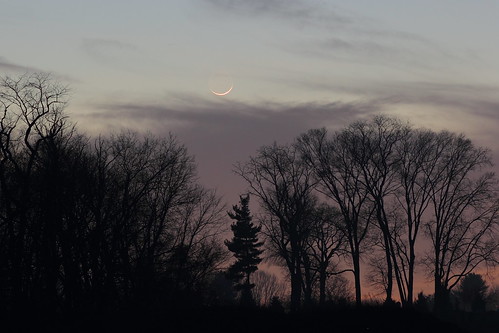
28 Hour Moon Setting over the Forest by Radical Retinoscopy, on Flickr
The 28 hour crescent moon was photographed setting over a small forest in Lancaster, PA on January 12, 2012. I managed to get only two shots before the moon was obscured by a passing cloud. The clouds added a bit of color and vibrancy to the western horizon.
http://www.flickr.com/photos/radicalret ... 374272125/
Copyright: Marion Haligowski

28 Hour Moon Setting over the Forest by Radical Retinoscopy, on Flickr
The 28 hour crescent moon was photographed setting over a small forest in Lancaster, PA on January 12, 2012. I managed to get only two shots before the moon was obscured by a passing cloud. The clouds added a bit of color and vibrancy to the western horizon.
-
broca
- Ensign
- Posts: 39
- Joined: Sat Jan 05, 2013 2:10 am
- AKA: Steve Coates
- Location: Ocala Florida
- Contact:
Submissions: 2013 January
IC 443 the Jellyfish nebula
http://coatesastrophotography.com/p6600 ... #h521a776c
Copyright: Coates Astrophotography IC 443 the Jellyfish nebula
Supernova remnant located in the constellation Gemini about 5,000 light years from Earth. A supernova remnant is the material expelled from a massive star that burned up all of it's fuel and collapsed onto itself.
Imaged from Ocala, Florida
January 11 and 12, 2012
RGB: 1 hour Red, 1 hour Green and 1 hour Blue (binned 1x1)
Ha: 4 hours (binned 1x1)
PS CS5
Orion 80mm EON (FL 480mm)
Orion 50mm guide scope with SSAG
QSI 683 ws
Losmandy G-11 with Gemini II
Astrodon Tru-balance E-Series Generation II LRGB filters
Baader 7 nm Ha filter
http://coatesastrophotography.com/p6600 ... #h521a776c
Copyright: Coates Astrophotography IC 443 the Jellyfish nebula
Supernova remnant located in the constellation Gemini about 5,000 light years from Earth. A supernova remnant is the material expelled from a massive star that burned up all of it's fuel and collapsed onto itself.
Imaged from Ocala, Florida
January 11 and 12, 2012
RGB: 1 hour Red, 1 hour Green and 1 hour Blue (binned 1x1)
Ha: 4 hours (binned 1x1)
PS CS5
Orion 80mm EON (FL 480mm)
Orion 50mm guide scope with SSAG
QSI 683 ws
Losmandy G-11 with Gemini II
Astrodon Tru-balance E-Series Generation II LRGB filters
Baader 7 nm Ha filter
-
terry.hancock
- Ensign
- Posts: 97
- Joined: Sat Jul 17, 2010 4:38 am
Re: Submissions: 2013 January
The Horsehead and The Flame Region of Orion
Copyright: Terry Hancock
http://www.flickr.com/photos/terryhanco ... hotostream The Horsehead Nebula
http://www.flickr.com/photos/terryhanco ... hotostream
Copyright: Terry Hancock
http://www.flickr.com/photos/terryhanco ... hotostream The Horsehead Nebula
http://www.flickr.com/photos/terryhanco ... hotostream
-
Lorenzo Comolli
- Ensign
- Posts: 86
- Joined: Sat Mar 05, 2011 9:18 pm
- Location: Italy
- Contact:
Re: Submissions: 2013 January
IC 2169 and 446 in Monoceros
Copyright: Lorenzo Comolli
http://www.astrosurf.com/comolli/index2.htm
[attachment=0]Comolli.jpg[/attachment]
http://www.astrosurf.com/comolli/d139m.jpg
Details: http://www.astrosurf.com/comolli/d139.htm
Copyright: Lorenzo Comolli
http://www.astrosurf.com/comolli/index2.htm
[attachment=0]Comolli.jpg[/attachment]
http://www.astrosurf.com/comolli/d139m.jpg
Details: http://www.astrosurf.com/comolli/d139.htm
Last edited by owlice on Tue Jan 15, 2013 4:23 am, edited 2 times in total.
Reason: Attached smaller image for faster downloading; left link to larger image. Thanks for sharing!
Reason: Attached smaller image for faster downloading; left link to larger image. Thanks for sharing!
Re: Submissions: 2013 January
The sun is raising its activity again:
Full size
Full size
-
Marco Angelini
- Ensign
- Posts: 40
- Joined: Sat Jan 07, 2012 12:44 am
Re: Submissions: 2013 January
IC 405: The Flaming Star Nebula in Auriga and the "runaway" blue-dwarf AE Aurigae
A fascinating chance encounter between a star and a nebula
Authors: M.Angelini, F.Antonucci, F.Tagliani - ADARA Astrobrallo
http://www.astrobrallo.com
Full-Res: http://www.astrobrallo.com/gallery/var/ ... 1358158914
Image Details: http://www.astrobrallo.com/gallery/inde ... r/IC-405-h
A fascinating chance encounter between a star and a nebula
Authors: M.Angelini, F.Antonucci, F.Tagliani - ADARA Astrobrallo
http://www.astrobrallo.com
Full-Res: http://www.astrobrallo.com/gallery/var/ ... 1358158914
Image Details: http://www.astrobrallo.com/gallery/inde ... r/IC-405-h
-
terry.hancock
- Ensign
- Posts: 97
- Joined: Sat Jul 17, 2010 4:38 am
Re: Submissions: 2013 January
M45 The Pleiades Cluster
Copyright: Terry Hancock
http://www.flickr.com/photos/terryhanco ... hotostream
Copyright: Terry Hancock
http://www.flickr.com/photos/terryhanco ... hotostream
Re: Submissions: 2013 January
NGC 2170 - "Rorschach" Reflection Nebula in Monoceros
Copyright: Lee Buck
http://lbuckphotos.smugmug.com/Astrophotography
This look to me like an "ink splat" . i realize this object was an APOD today (14 Jan.) with Ignacio's wonderful rendition of it, but I thought I would share my own version captured this week.
Lum: 24x15min(1x1); RGB: 16x10min each (2x2). January 8,9,11, 2013.
High Res Version Here
Copyright: Lee Buck
http://lbuckphotos.smugmug.com/Astrophotography
This look to me like an "ink splat" . i realize this object was an APOD today (14 Jan.) with Ignacio's wonderful rendition of it, but I thought I would share my own version captured this week.
Lum: 24x15min(1x1); RGB: 16x10min each (2x2). January 8,9,11, 2013.
High Res Version Here
Re: Submissions: 2013 January
Tidbinbilla NASA JPL Deep Space Tracking Station with Jupiter and moon conjunction
Copyright: Carlos Orue
[attachment=0]Tidbinbilla_Orue.jpg[/attachment]
Copyright: Carlos Orue
[attachment=0]Tidbinbilla_Orue.jpg[/attachment]
A closed mouth gathers no foot.
-
Harel_Boren
- Ensign
- Posts: 10
- Joined: Sat Nov 03, 2012 1:00 pm
Twin Quasar - First identified gravitationally lensed object
http://m1.i.pbase.com/o6/27/876727/1/14 ... xels02.jpg
Full resolution: http://m1.i.pbase.com/o6/27/876727/1/14 ... xels02.jpg
This image is 1600x900 pixels.
The Twin Quasar (Twin QSO or Double Quasar or Old Faithful), also known as SBS 0957+561, or TXS 0957+561 (also Q0957+561 or QSO 0957+561 A/B), was the first identified gravitationally lensed object.
The light recorded here started its journey before our solar system existed.
NGC 3079 is the small spiral galaxy in this image, in the winter constellation Ursa Major. It's distance of 50 million light years away is a mere stroll, as compared to the unimpressive two little objects it is pointing at (outlined) and which lay 10 arcmin. away, and shown in this image inside the red boxes (the right hand box is a zoom in image of the quasar).
These two images are in fact an image of one quasar - the most luminous kind of object in the universe. Quasars are the incredibly powerful cores of galaxies that are energized by super massive black holes gobbling up stars and other material.
QSO 0957+561 A (SBS 0957+561 A) and QSO 0957+561 B (SBS 0957+561 B) are the two components of a double-imaged quasar, meaning that an intervening mass concentration between Earth and the quasar bends light so that two images of the quasar appear in the sky. This is known as gravitational lensing, and is a consequence of Einsteinian warped space-time. The quasar lies at redshift z = 1.41 (8.7 billion ly), while the lensing galaxy lies at redshift z = 0.355 (3.7 billion ly). The lensing galaxy with apparent dimension of 0.42×0.22 arcminutes lies almost in line with the left image of the quasar, lying 1 arcsecond off. The astronomical data services SIMBAD and NASA/IPAC Extragalactic Database (NED) list several other names for this system.
The Twin Quasar's two images are separated by 6 arcseconds. Both images have an apparent magnitude of 17, with the right component having 16.7 and the left component having 16.5. There is a 417 ± 3 day time lag between the two images.
The lensing galaxy, YGKOW G1 (sometimes called G1 or Q0957+561 G1), is a giant elliptical (type cD) lying within a cluster of galaxies that also contribute to the lensing.
The quasars QSO 0957+561A/B were discovered in early 1979 by an Anglo-American team around Dennis Walsh, Robert Carswell and Ray Weyman, with the aid of the 2.1 m Telescope at Kitt Peak National Observatory in Arizona/USA. The team noticed that the two quasars were unusually close to each other, and that their redshift and visible light spectrum were surprisingly similar. They published their suggestion of "the possibility that they are two images of the same object formed by a gravitational lens".
The Twin Quasar was one of the first directly observable effects of gravitational lensing, which was first described in 1936 by Albert Einstein in his General Theory of Relativity.
Critics however identified a difference in appearance between the two quasars in radio frequency images. In mid 1979 a team led by David Roberts at the VLA (Very Large Array) near Socorro, New Mexico/USA discovered a relativistic jet emerging from quasar A with no corresponding equivalent in quasar B. Furthermore, the distance between the two images, 6 arcseconds, was too great to have been produced by the gravitational effect of the galaxy G1, a galaxy identified near quasar B.
Young et al. discovered that galaxy G1 is part of a galaxy cluster which increases the gravitational deflection and can explain the observed distance between the images. Finally, a team led by Marc V. Gorenstein observed essentially identical relativistic jets on very small scales from both the left and the right images of the quasar, in 1983 using VLBI (Very Long Baseline Interferometry). The difference between the large-scale radio images is attributed to the special geometry needed for gravitational lensing, which is satisfied by the quasar but not by all of the extended jet emission seen by the VLA near the right image.
Slight spectral differences between the two images of the quasar can be explained by different densities of the intergalactic medium in the light paths, resulting in differing extinction.[8]
30 years of observation made it clear that light forming the right image of the quasar reaches earth about 14 months earlier than the corresponding light forming the left image, resulting in a difference of path length of 1.1 ly.
(ref. http://en.wikipedia.org/wiki/Twin_Quasar; http://www.pbase.com/bkpeterson/image/123479749)
This image is 1600x900 pixels.
The Twin Quasar (Twin QSO or Double Quasar or Old Faithful), also known as SBS 0957+561, or TXS 0957+561 (also Q0957+561 or QSO 0957+561 A/B), was the first identified gravitationally lensed object.
The light recorded here started its journey before our solar system existed.
NGC 3079 is the small spiral galaxy in this image, in the winter constellation Ursa Major. It's distance of 50 million light years away is a mere stroll, as compared to the unimpressive two little objects it is pointing at (outlined) and which lay 10 arcmin. away, and shown in this image inside the red boxes (the right hand box is a zoom in image of the quasar).
These two images are in fact an image of one quasar - the most luminous kind of object in the universe. Quasars are the incredibly powerful cores of galaxies that are energized by super massive black holes gobbling up stars and other material.
QSO 0957+561 A (SBS 0957+561 A) and QSO 0957+561 B (SBS 0957+561 B) are the two components of a double-imaged quasar, meaning that an intervening mass concentration between Earth and the quasar bends light so that two images of the quasar appear in the sky. This is known as gravitational lensing, and is a consequence of Einsteinian warped space-time. The quasar lies at redshift z = 1.41 (8.7 billion ly), while the lensing galaxy lies at redshift z = 0.355 (3.7 billion ly). The lensing galaxy with apparent dimension of 0.42×0.22 arcminutes lies almost in line with the left image of the quasar, lying 1 arcsecond off. The astronomical data services SIMBAD and NASA/IPAC Extragalactic Database (NED) list several other names for this system.
The Twin Quasar's two images are separated by 6 arcseconds. Both images have an apparent magnitude of 17, with the right component having 16.7 and the left component having 16.5. There is a 417 ± 3 day time lag between the two images.
The lensing galaxy, YGKOW G1 (sometimes called G1 or Q0957+561 G1), is a giant elliptical (type cD) lying within a cluster of galaxies that also contribute to the lensing.
The quasars QSO 0957+561A/B were discovered in early 1979 by an Anglo-American team around Dennis Walsh, Robert Carswell and Ray Weyman, with the aid of the 2.1 m Telescope at Kitt Peak National Observatory in Arizona/USA. The team noticed that the two quasars were unusually close to each other, and that their redshift and visible light spectrum were surprisingly similar. They published their suggestion of "the possibility that they are two images of the same object formed by a gravitational lens".
The Twin Quasar was one of the first directly observable effects of gravitational lensing, which was first described in 1936 by Albert Einstein in his General Theory of Relativity.
Critics however identified a difference in appearance between the two quasars in radio frequency images. In mid 1979 a team led by David Roberts at the VLA (Very Large Array) near Socorro, New Mexico/USA discovered a relativistic jet emerging from quasar A with no corresponding equivalent in quasar B. Furthermore, the distance between the two images, 6 arcseconds, was too great to have been produced by the gravitational effect of the galaxy G1, a galaxy identified near quasar B.
Young et al. discovered that galaxy G1 is part of a galaxy cluster which increases the gravitational deflection and can explain the observed distance between the images. Finally, a team led by Marc V. Gorenstein observed essentially identical relativistic jets on very small scales from both the left and the right images of the quasar, in 1983 using VLBI (Very Long Baseline Interferometry). The difference between the large-scale radio images is attributed to the special geometry needed for gravitational lensing, which is satisfied by the quasar but not by all of the extended jet emission seen by the VLA near the right image.
Slight spectral differences between the two images of the quasar can be explained by different densities of the intergalactic medium in the light paths, resulting in differing extinction.[8]
30 years of observation made it clear that light forming the right image of the quasar reaches earth about 14 months earlier than the corresponding light forming the left image, resulting in a difference of path length of 1.1 ly.
(ref. http://en.wikipedia.org/wiki/Twin_Quasar; http://www.pbase.com/bkpeterson/image/123479749)
Last edited by owlice on Tue Jan 15, 2013 4:02 pm, edited 2 times in total.
Reason: please, no hot links to images > 400kb
Reason: please, no hot links to images > 400kb
Re: Submissions: 2013 January
Re: Submissions: 2013 January
hello
please find this HDR wiew of moon taken last night...
refractor 150 mm F/7.5 (doublet air spaced)
eos 5DMII 1600 iso
process by PHOTOMATIX 4.2 PRO
fusion of 4 expositions: 3.2; 1.3; 1/125; 1/400 sec
best regards
image by Philippe TOSI (FRANCE-Nîmes)
please find this HDR wiew of moon taken last night...
refractor 150 mm F/7.5 (doublet air spaced)
eos 5DMII 1600 iso
process by PHOTOMATIX 4.2 PRO
fusion of 4 expositions: 3.2; 1.3; 1/125; 1/400 sec
best regards
image by Philippe TOSI (FRANCE-Nîmes)
Re: Submissions: 2013 January
hello
tonight i try a new test of HDR image with a self made newton 410 mm F/5.6
fusion by PHOTOMATIX 4.2 PRO developped by HDRsoft (natural fusion) of 6 exposures:
1/2500; 1/500; 1/60; 1/5; 0.6; 1.6 sec
canon eos 5DMII 800 iso.
best regards
image Philippe TOSI (FRANCE-Nîmes)
tonight i try a new test of HDR image with a self made newton 410 mm F/5.6
fusion by PHOTOMATIX 4.2 PRO developped by HDRsoft (natural fusion) of 6 exposures:
1/2500; 1/500; 1/60; 1/5; 0.6; 1.6 sec
canon eos 5DMII 800 iso.
best regards
image Philippe TOSI (FRANCE-Nîmes)
-
Emre Can Alagoz
- Asternaut
- Posts: 1
- Joined: Tue Jan 15, 2013 8:51 pm
Re: Submissions: 2013 January
http://g1301.hizliresim.com/15/h/hzsjv.png
06.06.2012 Venus Transit before Anticrepuscular Rays Over Istanbul. Pictured above is a particularly striking set of anticrepuscular rays photographed last year near K.Cekmece, Istanbul, Turkey.
Photograph young amateur astronom Emre Can Alagoz.
http://d1301.hizliresim.com/15/h/hzsw7.jpg : Orginal Size
Photograph young amateur astronom Emre Can Alagoz.
http://d1301.hizliresim.com/15/h/hzsw7.jpg : Orginal Size
Last edited by owlice on Wed Jan 16, 2013 2:50 am, edited 2 times in total.
Reason: Attached smaller image for faster downloading; left link to larger image. Please keep images under 400K. Thanks for sharing!
Reason: Attached smaller image for faster downloading; left link to larger image. Please keep images under 400K. Thanks for sharing!
Re: Submissions: 2013 January
http://www.flickr.com/photos/airliner/8380184714/
Hello to Starship Asterisk community,
Here is an image of the waxing crescent moon as appeared from my hometown Kavala, Greece on January 13, 2013
Mavroudakis Fotis
Kavala, Greece
Hello to Starship Asterisk community,
Here is an image of the waxing crescent moon as appeared from my hometown Kavala, Greece on January 13, 2013
Mavroudakis Fotis
Kavala, Greece
Last edited by owlice on Wed Jan 16, 2013 7:01 am, edited 1 time in total.
Reason: Changed URLs to make image display, as the original link was to a webpage rather than an image; thanks for sharing!
Reason: Changed URLs to make image display, as the original link was to a webpage rather than an image; thanks for sharing!
Re: Submissions: 2013 January
Hello to Starship Asterisk Community
This is my first submmision of the waxing crescent moon as appeared on January 13, 2013 over my hometown Kavala, Greece.
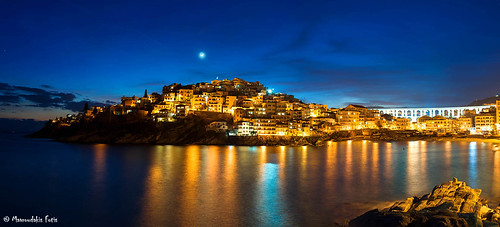
Waxing crescent moon over the city by Mavroudakis Fotis, on Flickr
I hope you like it
Thank you all
Mavroudakis Fotis
Kavala, Greece
http://www.flickr.com/photos/airliner/
This is my first submmision of the waxing crescent moon as appeared on January 13, 2013 over my hometown Kavala, Greece.

Waxing crescent moon over the city by Mavroudakis Fotis, on Flickr
I hope you like it
Thank you all
Mavroudakis Fotis
Kavala, Greece
http://www.flickr.com/photos/airliner/
-
Jeff Dai
Re: Submissions: 2013 January
Moonlight Shuangqiao Valley
http://www.flickr.com/photos/jeffdai/83 ... otostream/
Moonlight shining on Shuangqiao Valley, a world heritage site of Sichuan Giant Panda Sanctuaries ( http://whc.unesco.org/en/list/1213 ) in western China.
The seven stars of big dipper are easily find above the mountain .The two head stars of the dipper are the "Pointers" to the northern star, Polaris. Following the curve along the handle of the dipper leads you to bright star Arcturus, rises over the snow mountain.
Moonlight shining on Shuangqiao Valley, a world heritage site of Sichuan Giant Panda Sanctuaries ( http://whc.unesco.org/en/list/1213 ) in western China.
The seven stars of big dipper are easily find above the mountain .The two head stars of the dipper are the "Pointers" to the northern star, Polaris. Following the curve along the handle of the dipper leads you to bright star Arcturus, rises over the snow mountain.
Last edited by owlice on Wed Jan 16, 2013 3:01 pm, edited 1 time in total.
Reason: Added URL for image; left existing URL to page. Fixed other URL.
Reason: Added URL for image; left existing URL to page. Fixed other URL.
Submissions: 2013 January
Colorful startrails at Sunset
http://miguelclaro.com
Copyright: Miguel Claro After the sunset, the sky takes fantastic colors and warm tones full of life. While waiting for the night fall to become the visible clouds of dust and gas in our galaxy, I registered a startrail a little different than usual, where are clearly distinguishable the different colors of different stars. In astronomy, the yellow/orange stars are more cold than the white/blue stars. A curiosity, is that the track nearest the rock and water, in the left area of the image, refers to the planet Mars, who was also visible when I started the session. In the atlantic ocean, the waves dragged the foam that was drawing the sand and reflecting a magnificent sky full of light and color .
Image taken in the Adraga beach, in Sintra, Portugal.
Canon 50D - 16mm f/5.6 Exp. 30" at ISO800. Sum of 70 images, taken in 02/12/2012 between 18h24 and 19h02.
http://miguelclaro.com
Copyright: Miguel Claro After the sunset, the sky takes fantastic colors and warm tones full of life. While waiting for the night fall to become the visible clouds of dust and gas in our galaxy, I registered a startrail a little different than usual, where are clearly distinguishable the different colors of different stars. In astronomy, the yellow/orange stars are more cold than the white/blue stars. A curiosity, is that the track nearest the rock and water, in the left area of the image, refers to the planet Mars, who was also visible when I started the session. In the atlantic ocean, the waves dragged the foam that was drawing the sand and reflecting a magnificent sky full of light and color .
Image taken in the Adraga beach, in Sintra, Portugal.
Canon 50D - 16mm f/5.6 Exp. 30" at ISO800. Sum of 70 images, taken in 02/12/2012 between 18h24 and 19h02.





